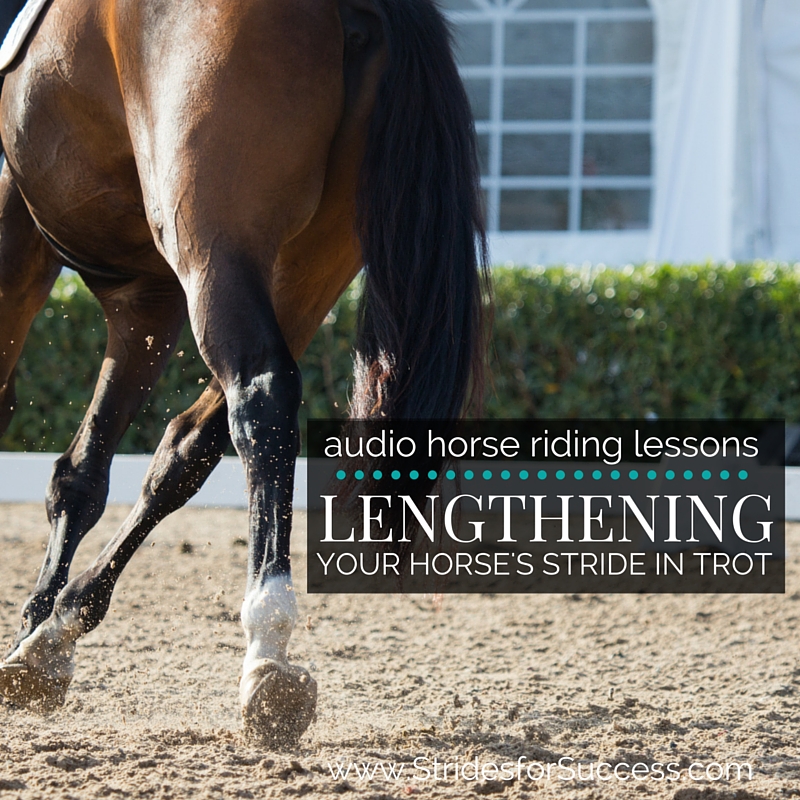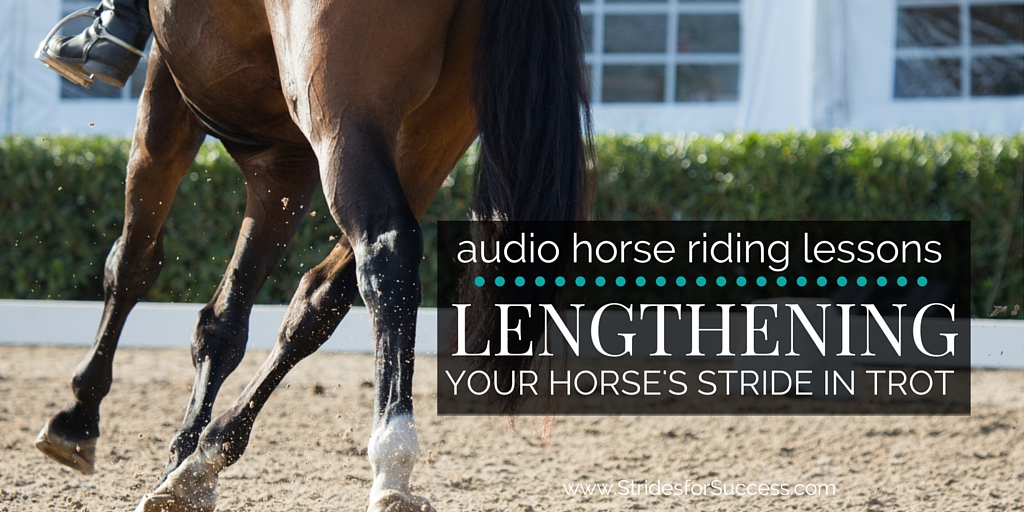We have all seen the wonderful video clips of horses showing extravagant extensions in the trot and I think most riders dream of being able to perform a similar feat. However, for most riders, merely asking for a lengthening of the stride in trot results in their horse either breaking into a canter or running on to their forehand, with the hind end being, well, left behind!
Being able to lengthen and then subsequently shorten your horse’s stride when you want, develops your horse’s responsiveness, suppleness, and balance while being ridden.
It also allows you to make adjustments if necessary while in the saddle, without changing from one gait to another.
However, it takes time for your horse to develop physically and mentally so as to begin holding a lengthened stride for longer periods. Failure to do so is often a lack of patience from riders, who will try to push and force their horse to lengthen. This results in the horse hollowing his back, shortening the stride, and rushing onto the forehand.
What is Lengthening the Stride?
When your horse lengthens, he basically covers more ground in the same amount of strides. Each stride he takes sees him stretching or reaching more forward. His hind feet coming more underneath him with every stride and then the front legs stretching out more in front of him with each stride.
However, when lengthening his stride, he will not change the tempo of the gait. The 1 – 2 – 1 – 2 – 1 – 2 of the trot will remain the same, regardless of the length of the stride or ground being covered with each passing stride.
Asking, not pushing is the key to a true lengthening on the stride in trot.
In order to lengthen his stride, your horse must lengthen his whole back and topline. Suppleness is required to do this, and often we only think of suppleness as being lateral, it is also important longitudinal as well.
Start with Rhythm
The rhythm and tempo of the trot should remain consistent throughout the gait. I think that this is often the most simple place and way to begin introducing your horse to this type of work. Start by becoming familiar with your horses tempo and knowing the length of this strides in working trot.
Depending on how independent and ‘under control’ your seat is, you can lengthen your horse in trot from either rising trot or sitting trot,
I strongly suggest working in rising trot initially as it will allow your horses back to lengthen out without you being heavy on it during the longer strides.
I also find that using rising trot tends to prevent an overly ambitious ‘seat shoving’ happening from the rider, whether intentional or not!
So first and foremost, focus on creating and then maintaining or establishing a correct and balanced rhythm and tempo.
You can do this through all three gaits, using the transitions to further engage your horse’s hind quarters and also, refine your aids and your horse’s responsiveness to them.
Pay Attention to Straightness
It is also important to cultivate straightness in your horse. Doing this earlier on will make it easier for him later when you begin asking for the lengthened strides. If you horse is straight, he will push equally from both hind legs, propelling him correctly in the gait.
If he is crooked or falling out, he will find it hard to maintain a rhythm, as one side will literally be moving more forward than the other.
Spend quite a bit of time on transitions, using your half halts, and circles, particularly smaller ones, such as 12 or 10 meter circles. Work between shortening your horse slightly and then returning back to working trot as well. Don’t attempt to lengthen until you have truly established and can maintain a good balance throughout the above mentioned exercises.
Begin By Shortening First…
I find that riders often find lengthening the canter easier than the trot, particularly when there are canter poles involved. However, you can use a similar principle in the trot when starting out at first. Pick two fixed points in the arena or on the trail where you are riding. Ride between these two points quite a few times in working trot, counting each time the amount of strides your horse fits between the two points.
Use your body passing the first point as the ‘go’ or ‘start’ and then again, your body passing the second point as your ‘stop’ or ‘end’. Continue to do so until you have a regular amount of strides each time as you ride through this movement.
Think of it almost as having two ground poles with 5 or 6 canter strides in between, but use the points you have chosen as the poles and trot rather than canter.
Once you know the amount of strides in a ‘normal’ working trot, then ask for a slight shortening of the stride between the two points. If you can get an extra stride in there, then your horse has truly shortened. However remember the tempo or recurrence of the 1 – 2 – 1 – 2 – 1 – 2 must remain the same throughout.
The shortening of the stride can be thought of as your horse lifting his legs more ‘up’ rather than ‘out in front’.

Asking for Lengthened Strides
Once you and your horse have established a balanced transition between the working trot and a slightly shorter more collected trot, you can then begin to think about asking for a few lengthened strides in the trot. It is really important to maintain the contact between you and your horse throughout the movement.
Lengthening the stride does not mean throwing the reins at your horse and kicking on. It simply means that you are allowing your horse more space to move within each stride.
You may find, particularly if it is your horse’s first time, that initially there will be very little difference. This is fine, your horse has to first understand what you are asking and then also, begin to understand how he can move his body to achieve this new lengthening of it.
Remember, when you horse lengthens his stride, he will use his muscles, tendons, ligaments and joints differently. Slow and steady, taking plenty of time to learn this correctly, is key to maintaining a sound horse that enjoys his job.
Noticing the Increased Lenght
If he does begin to lengthen the stride, you will count less strides between your ‘start’ and ‘end’ points than what you were counting while in working trot or whatever you are using as your ‘control gait’. I say ‘control gait, as in order to know if your horse is lengthening rather than running, you need something to measure it against. Use your working trot as the measure or the control.
Keep in mind that your horse cannot move or ‘extend’ his shoulders if you are leaning or jiggling around on top of them.
Pay attention to your position and posture throughout the exercise, and again, take things slowly. The better your horse understands and the more confident he feels about his ability to perform the movement, the greater it will eventually be.
Happy Riding
Lorna
Additional Resources for Equestrians:-
-
-
- FREE Half Halt Training Audio
- The Aids to Ride the Half Halt
- Harnessing the Power of the Half Halt
- Improving Your Ride with the Half Halt
- Understanding and Refining Your Half Halt
- Your Half Halt on the Ground with Your Horse
- Connection in Your Riding; Your Seat and Legs
- Connection; My Online Membership for Equestrians
- Online community for equestrians working on their mindset & fitness
- Online Community for equestrians focusing on re-schooling horses (and ex-racehorses
-

[wp-tiles post_type=”post” orderby=”date” order=”DESC” grids=”Simple”]
